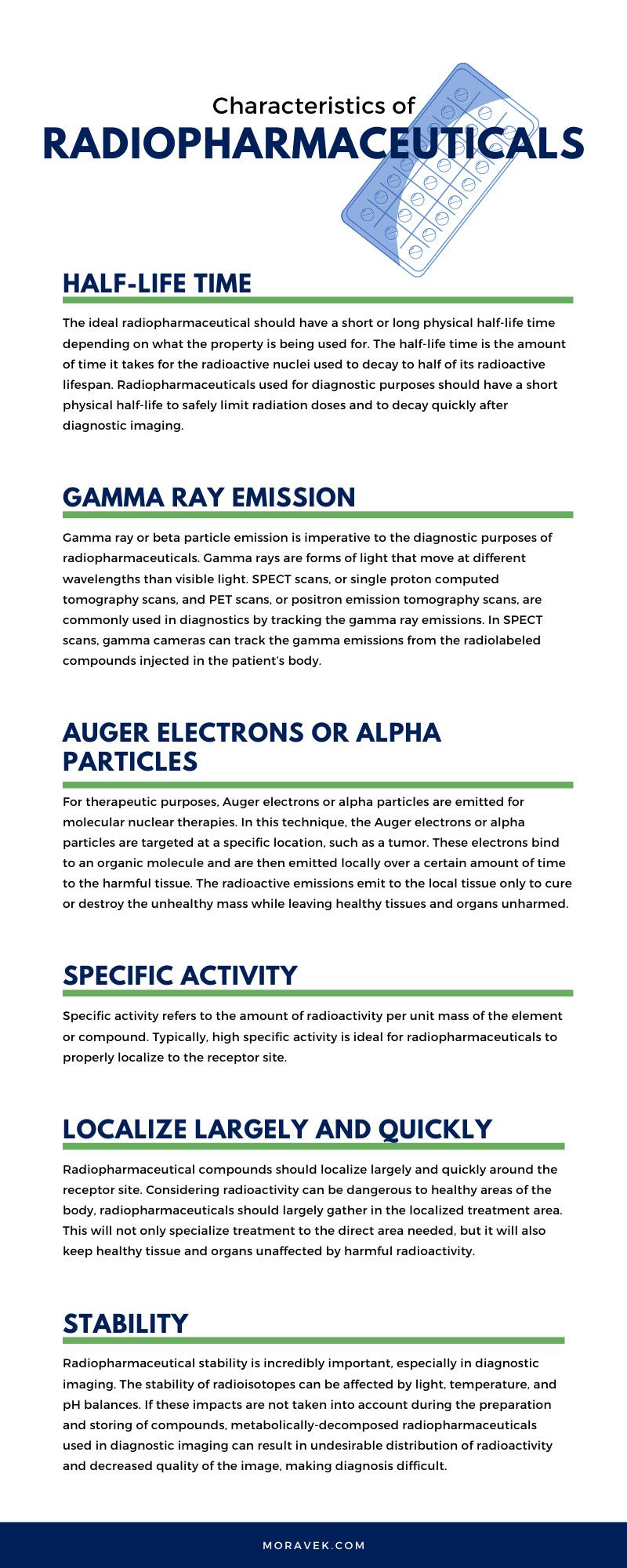
Radiopharmaceuticals are a drug grouping of unique medicinal formations. These formations use radioactive isotopes, also known as radioisotopes, in clinical diagnosis, as well as for therapeutic interventions. Common uses of radiopharmaceuticals in clinical diagnoses are to determine the functioning of the liver, lungs, and kidneys, blood flow to the brain, bone growth, the predictive effects of surgery, and to assess changes since treatment. Common uses of radiopharmaceuticals in therapeutic interventions are cancer and tumor treatment, thyroid disease, palliative treatment of bone metastasis, and arthritis.
Radiopharmaceuticals actively emit radiation. The compound can be used for diagnosis or therapy, depending on what type of radiation it emits. For example, a compound that emits beta or gamma ray particles can be used for diagnosis, whereas a compound that emits alpha particles will generally be used for therapeutic interventions. Beta particles and alpha particles are a few of the characteristics of radiopharmaceuticals. Here are some of the most ideal characteristics of radiopharmaceutical compounds.
Half-Life Time
The ideal radiopharmaceutical should have a short or long physical half-life time depending on what the property is being used for. The half-life time is the amount of time it takes for the radioactive nuclei used to decay to half of its radioactive lifespan. Radiopharmaceuticals used for diagnostic purposes should have a short physical half-life to safely limit radiation doses and to decay quickly after diagnostic imaging. Therapeutic uses of radiopharmaceuticals should have a long physical half-life, as a short decay period would decrease the therapeutic properties of the compound, making it less effective as time goes on. In diagnostic imagining, the effective half-life time should also be equal to the examination period. Effective half-life time is the amount of time it takes for the radioactivity in specific radioactive substances distributed in the body to decrease to half of their radioactive lifespan. This eliminates overexposure for radioactivity to the human body beyond the examination period.
Gamma Ray Emission
Gamma ray or beta particle emission is imperative to the diagnostic purposes of radiopharmaceuticals. Gamma rays are forms of light that move at different wavelengths than visible light. SPECT scans, or single proton computed tomography scans, and PET scans, or positron emission tomography scans, are commonly used in diagnostics by tracking the gamma ray emissions. In SPECT scans, gamma cameras can track the gamma emissions from the radiolabeled compounds injected in the patient’s body. Through the gamma ray emission, SPEC scans can diagnose and track the progression of heart diseases, bone disorders, movement disorders, dementia, and Parkinson’s disease. PET scans do not measure the gamma rays emitted. In a PET scan, the decay of the radiolabeled compound creates small particles called positrons. Positrons then interact with electrons in the body to create photons that can be measured and used to create images of internal organs.
Auger Electrons or Alpha Particles
For therapeutic purposes, Auger electrons or alpha particles are emitted for molecular nuclear therapies. In this technique, the Auger electrons or alpha particles are targeted at a specific location, such as a tumor. These electrons bind to an organic molecule and are then emitted locally over a certain amount of time to the harmful tissue. The radioactive emissions emit to the local tissue only to cure or destroy the unhealthy mass while leaving healthy tissues and organs unharmed.
Specific Activity
Specific activity refers to the amount of radioactivity per unit mass of the element or compound. Typically, high specific activity is ideal for radiopharmaceuticals to properly localize to the receptor site.
Localize Largely and Quickly
Radiopharmaceutical compounds should localize largely and quickly around the receptor site. Considering radioactivity can be dangerous to healthy areas of the body, radiopharmaceuticals should largely gather in the localized treatment area. This will not only specialize treatment to the direct area needed, but it will also keep healthy tissue and organs unaffected by harmful radioactivity. Localizing to the treatment area quickly also allows for the treatment to take place faster, which is often needed in diagnostics or life-saving treatments such as tumor removal.
Stability
Radiopharmaceutical stability is incredibly important, especially in diagnostic imaging. The stability of radioisotopes can be affected by light, temperature, and pH balances. If these impacts are not taken into account during the preparation and storing of compounds, metabolically-decomposed radiopharmaceuticals used in diagnostic imaging can result in undesirable distribution of radioactivity and decreased quality of the image, making diagnosis difficult.
Cost, Availability, and Care
Design characteristics are imperative to the creation of radiopharmaceutical compounds. While the design of a compound heavily relies on the characteristics previously listed, the ease, availability, and cost of production are also important factors. Like any clinical trial or treatment, the availability and cost of production play a large role in creating beneficial radiopharmaceuticals. Pharmaceutical manufacturing companies must consider the cost of production and the wide-scale availability of elements needed such as the appropriate nuclide needed for treatment or diagnosis. Proper storage availability must be accounted for as well. Radiopharmaceuticals actively emit radiation; therefore, they must be able to be stored in a designated area, such as a sealed container to lower potential exposure to the safest and minimal levels.
Safety
Radiopharmaceuticals can be a dangerous industry, like any pharmaceutical production proper policies and procedures that are in place to handle the creation of compounds. Good Manufacturing Practices must be followed such as proper sanitization and proper labeling on materials, to safely handle any pharmaceutical compounds. In radiopharmaceuticals specifically, the As Low As Responsibly Achievable or ALARA principle must be followed. This concept requires that exposure to radiation is minimized as much as possible, proper shielding from the radiation source is present, and the maximum proper distance between personnel and the radiation source is achieved.
Radiopharmaceuticals have a wide array of uses in the pharmaceutical industry from heart disease diagnosis to therapeutic treatment of cancerous tumors or thyroid disease. Radiopharmaceuticals require specific characteristics in their composition and creation to successfully diagnose and treat health complications. Half-life time, gamma ray particles, alpha particles, specific activity, localization, stability, and the design and care preparations all play imperative roles in radiopharmaceutical compound creation and composition.

